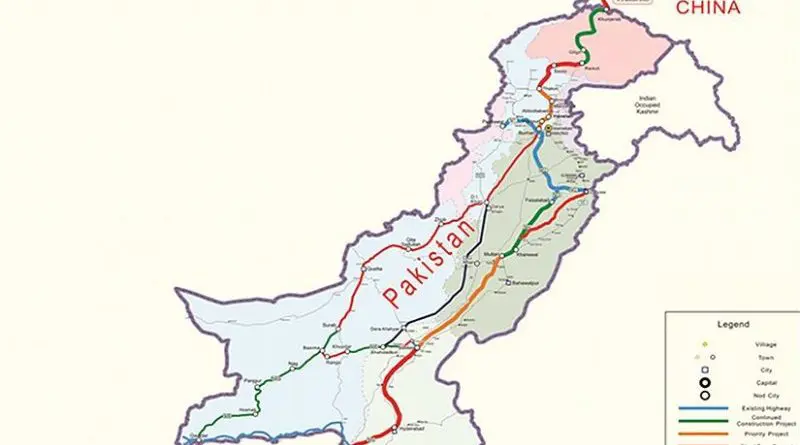CPEC’s Infrastructure Development And Employment Generation – OpEd
By Shah Khalid
The China-Pakistan Economic Corridor (CPEC) stands as a testament to the deepening economic ties between China and Pakistan. Rooted in historical cooperation, CPEC has evolved into a comprehensive infrastructure development initiative that spans a multitude of sectors, promising to reshape the economic landscape of both nations. This piece delves into the current state of CPEC, focusing on its economic impact and, more specifically, the job opportunities it has generated.
Originating from a long-standing strategic partnership, CPEC has its roots in the historical camaraderie between China and Pakistan. The initiative gained momentum in recent years with a focus on developing infrastructure and fostering economic connectivity. Key projects under CPEC include the construction of highways, railways, and energy infrastructure. The China-Pakistan relationship has thus transcended diplomatic ties, manifesting in a collaborative effort to bolster economic growth and development.
Economic Impact and Growth
CPEC has been a catalyst for economic growth in both China and Pakistan. The initiative has contributed significantly to the Gross Domestic Product (GDP) of both nations, fostering economic development and opening avenues for increased trade and investment. The robust infrastructure development facilitated by CPEC has enhanced connectivity, reduced transportation costs and promoting efficiency in trade activities.
One of the most tangible outcomes of CPEC is the creation of job opportunities, addressing unemployment and underemployment in both countries. The direct employment generated by the construction and development projects is substantial. Skilled and unskilled labor alike find opportunities in the various facets of infrastructure development, from building highways to constructing power plants. This has not only improved the livelihoods of many but has also played a crucial role in poverty alleviation.
Indirect employment is another facet of the job landscape influenced by CPEC. The service sectors, including hospitality and transportation, have experienced growth due to increased economic activity. Hotels and restaurants along CPEC routes witness heightened demand, while transportation services are essential for the movement of goods and people. The ripple effect of CPEC extends to manufacturing and supply chain industries, further amplifying the job market.
Skills Development and Training Programs
Recognizing the importance of a skilled workforce in sustaining economic growth, CPEC has spurred various skills development and training programs. Vocational training initiatives have been implemented to equip individuals with the skills needed for specific jobs in the infrastructure and related industries. These programs not only enhance employability but also contribute to the overall human capital development of the region.
Education and capacity building are integral components of CPEC’s strategy to create a sustainable job market. By investing in education, particularly in science, technology, engineering, and mathematics (STEM) fields, both China and Pakistan aim to create a workforce that can actively contribute to the technological advancements accompanying infrastructure development.
While the economic impact of CPEC is evident, it is crucial to address challenges and concerns associated with the initiative. Socio-economic and environmental challenges, such as the displacement of local communities and ecological impacts of large-scale projects, require careful consideration. Balancing local and foreign employment is another challenge, with the need to ensure that the benefits of job creation are equitably distributed among the population. Addressing community concerns and grievances is paramount for the sustainable success of CPEC. Open and transparent communication between project stakeholders and local communities is essential to mitigate potential tensions and build a harmonious relationship. Striking a balance between economic development and social and environmental responsibility is a delicate task that necessitates thoughtful policies and proactive community engagement.
Conclusion
Considering the multifaceted impact of CPEC on job opportunities, several recommendations emerge. Policymakers should focus on formulating strategies that optimize job creation, considering the specific needs and challenges of different regions. Community engagement and empowerment should be prioritized to foster a sense of ownership and inclusivity in the development process. Collaboration between the public and private sectors is essential for the success of CPEC. By leveraging the strengths of both, a conducive environment for sustainable job creation can be fostered. The benefits of CPEC should not be confined to economic indicators alone but should translate into tangible improvements in the quality of life for the people of China and Pakistan. Thus, the current state of CPEC reflects a transformative journey towards economic prosperity and connectivity. The initiative’s impact on job opportunities is a key driver of its success, contributing to poverty reduction, skills development, and overall economic growth. As CPEC continues to evolve, careful attention to challenges and a commitment to inclusive and sustainable development will be crucial in realizing its full potential.

